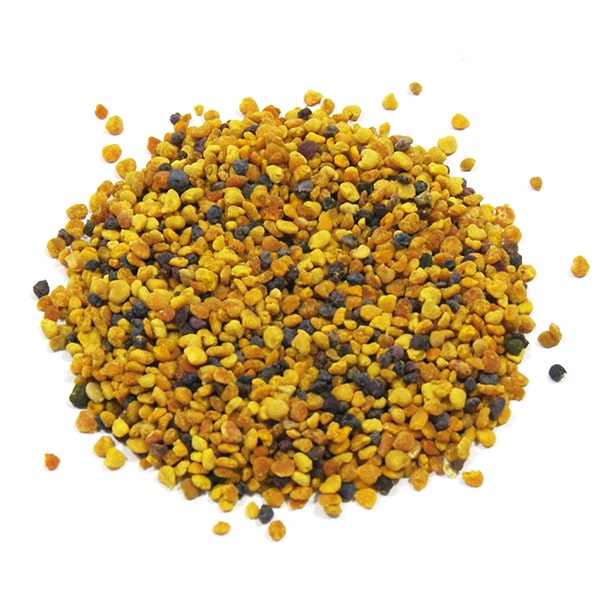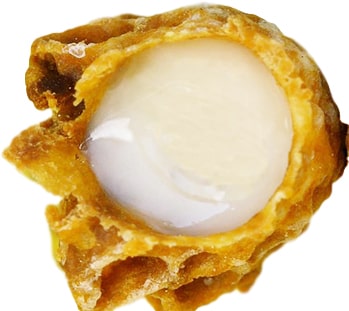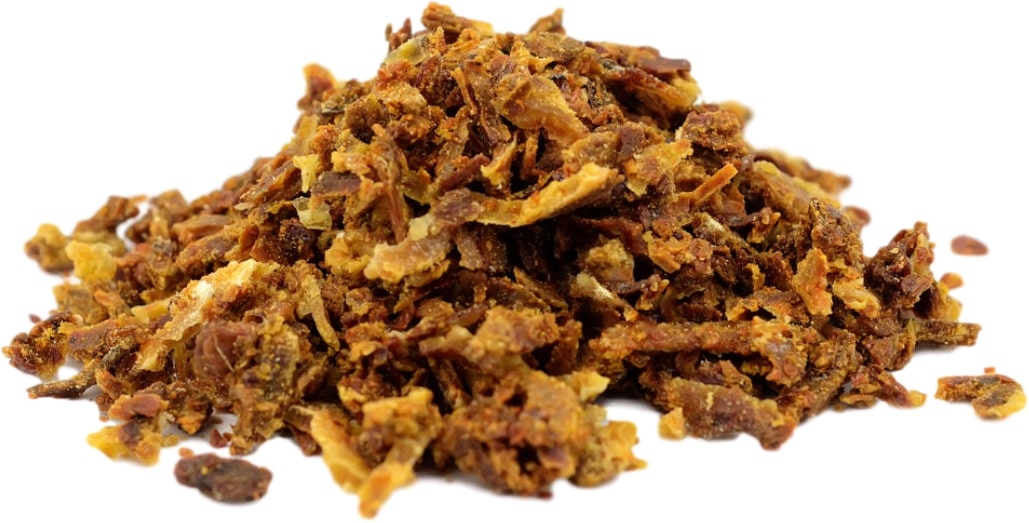Settings
Shipping country
Languages
Bee-products-FAQ
Bee Pollen:

What is bee pollen? Bee pollen consists of plant dust from the male germ cells of the flowering plants. The pollen forms in the stamens of the flowers and is stored there until they are ready. When the pollen sacks, which are located at the top of the stamens, are ripe, their walls burst, and the pollen grains are released.
What do pollen look like? Pollen has many different forms. Spherical, oval, cube-shaped and pyramid-shaped pollen grains are known. Even those with air bags for better distribution by the wind. To differentiate between the many shapes and surfaces, the pollen must be magnified over 100 times in a microscope, because they are only less than a twentieth of a millimeter in size. As small as the individual pollen grain is, the total is large: up to several million per flower. The color of the pollen is not just yellow or orange. For example, the pollen of lavender is deep blue.
If you spot a bee shortly before its flight home, two small balls can often be recognized on its hind legs. There are thousands of collected pollen in the balls, clustered into so-called "pollen pants". A single bee colony carries over 60,000 such "panties" into the beehive on a summer day.
Bees instinctively know that honey alone, despite its high calorie content, is not enough to raise the young bees. Even the queen bee would not be able to lay up to 2000 eggs a day without the royal jelly that is made from pollen and honey.
How are pollen harvested? With the pollen trap. This is nothing more than a kind of comb that is attached to the entrance of the apiary and that the bees pass through on arrival. This procedure removes the pollen panties. This process is painless for the bee.
What do bee pollen contain? Pollen grains contain vitamins, nutrients and minerals. Vitamins and provitamins carotene, the B complex, vitamin C D E and "vitamin-like" flavones have been proven. Around a quarter of the pollen mass consists of protein (with essential amino acids) and carbohydrates. Quantities of phosphorus and especially potassium stand out among the minerals found. Magnesium and calcium are also present in significant quantities. Added to this are phytohormones and ferments.
Royal jelly:

Royal jelly is also known as queen jelly or white jelly. It is a secretion that the worker bees (nurse bees) produce in their hypopharyngeal and mandibular glands.
The bees are fed with royal jelly only in the first 3 days. In these 3 days they show an intensive development. In only three days they reach 250 times their body weight. The larva of the worker bee then only receives pollen and honey. In summer, the bees reach an average age of 38 days.
The queen bee, on the other hand, is fed with this royal jelly until her cell is covered. However, the queen bee is also fed royal jelly later. In this way it reaches an age of 4 to 5 years and is capable of top performances in other respects as well. At peak times she can lay up to 2000 eggs per day.
The development of the queen bee is an interesting research topic that is still being intensively studied. For example, a study by the entomologist Berenbaum has shown that it makes a difference whether the bee is fed on food of plant origin or whether it is produced by the bees themselves, as is the case with royal jelly.
Royal jelly consists of around 70 percent water; the remaining 30 percent is half protein. In addition, there are carbohydrates and fats. The detailed composition can be found here.
Honey wine (mead):
Original mead, also called honey wine, is an alcoholic beverage made from honey, water and yeast and is professionally produced today. Nowadays you often create mixed drinks with mead, fruit juices and spices.
However, honey was one of the most valuable goods in the earliest cultures. This also applies to the mead produced from it. The word "mead" comes from the Indo-European "medhu", which means something like sweet potion. It is certain that mankind's first alcoholic beverages were wine and honey wine, although the production of mead is said to be somewhat older than the wine-making process. Wine had been known in the Near East and Egypt since 3500 BC.
One explanation for the early invention of mead is the insufficiently airtight storage of pollen. As excavations show, pollen was taken by the Nordic peoples in winter and on long cruises to prevent scurvy (vitamin deficiency disease). These pollen stocks were overlaid with honey to keep them from spoiling. Then a spontaneous fermentation started, for example when using honey with a too high-water content or when a container was leaking, and the contents could extract water from the air. This is how mead was created unintentionally.
Because of this spontaneous fermentation, our ancestors believed for thousands of years that mead was a gift from the gods. In pre-Christian mythology it was the drink of feast and joy. In its sweetness, mead seemed to them like a drink from the gods, with the help of which divine power could be transmitted to people at their festivals and banquets and thus brought them into connection with the gods.
Later one learned to appreciate the delicious mead in Rome. Captured mead jugs received enthusiastic written mention in the annals of Roman historiography. Mead was given a place of honor on Roman banquets, in addition to the cheaper drinks made from grapes. Because of the much simpler production, the wine made from grapes remained the most widespread table drink in terms of quantity even after the fall of the Roman Empire.
It was only through their raids and later trade that the Vikings acquired the knowledge to produce mead. Due to the cold climate, it was not possible to grow wine in Scandinavia and so they could not make wine. However, this drink was known to the Norsemen from the Romans and it was not for nothing that they were known for their ingenuity. So, they took honey and added captured wine and it made a sweet alcoholic drink. Since alcohol loosens the tongue, the Vikings named the drink after the Skaldenmet, the drink of Nordic mythology who bestowed poetry on anyone who enjoyed it.
Propolis:

The name propolis comes from the Greek and means pro = before, polis = city. That means the enemies must stay in front of the city.
It is a substance that protects the bee colony from harmful pathogens. Propolis is a putty-like brown substance with which the bees cover their hive entrance, the hive walls and the honeycomb. The bees collect resin from the buds and barks of various trees, which they then upgrade with secretions from their bodies to propolis.
Contents: vitamins, numerous acids, fatty acids, cinnamic acid, cinnamon alcohol, minerals, many trace elements, resins, balms and wax, essential oils, enzymes and flavones.

What is bee pollen? Bee pollen consists of plant dust from the male germ cells of the flowering plants. The pollen forms in the stamens of the flowers and is stored there until they are ready. When the pollen sacks, which are located at the top of the stamens, are ripe, their walls burst, and the pollen grains are released.
What do pollen look like? Pollen has many different forms. Spherical, oval, cube-shaped and pyramid-shaped pollen grains are known. Even those with air bags for better distribution by the wind. To differentiate between the many shapes and surfaces, the pollen must be magnified over 100 times in a microscope, because they are only less than a twentieth of a millimeter in size. As small as the individual pollen grain is, the total is large: up to several million per flower. The color of the pollen is not just yellow or orange. For example, the pollen of lavender is deep blue.
If you spot a bee shortly before its flight home, two small balls can often be recognized on its hind legs. There are thousands of collected pollen in the balls, clustered into so-called "pollen pants". A single bee colony carries over 60,000 such "panties" into the beehive on a summer day.
Bees instinctively know that honey alone, despite its high calorie content, is not enough to raise the young bees. Even the queen bee would not be able to lay up to 2000 eggs a day without the royal jelly that is made from pollen and honey.
How are pollen harvested? With the pollen trap. This is nothing more than a kind of comb that is attached to the entrance of the apiary and that the bees pass through on arrival. This procedure removes the pollen panties. This process is painless for the bee.
What do bee pollen contain? Pollen grains contain vitamins, nutrients and minerals. Vitamins and provitamins carotene, the B complex, vitamin C D E and "vitamin-like" flavones have been proven. Around a quarter of the pollen mass consists of protein (with essential amino acids) and carbohydrates. Quantities of phosphorus and especially potassium stand out among the minerals found. Magnesium and calcium are also present in significant quantities. Added to this are phytohormones and ferments.
Royal jelly:

Royal jelly is also known as queen jelly or white jelly. It is a secretion that the worker bees (nurse bees) produce in their hypopharyngeal and mandibular glands.
The bees are fed with royal jelly only in the first 3 days. In these 3 days they show an intensive development. In only three days they reach 250 times their body weight. The larva of the worker bee then only receives pollen and honey. In summer, the bees reach an average age of 38 days.
The queen bee, on the other hand, is fed with this royal jelly until her cell is covered. However, the queen bee is also fed royal jelly later. In this way it reaches an age of 4 to 5 years and is capable of top performances in other respects as well. At peak times she can lay up to 2000 eggs per day.
The development of the queen bee is an interesting research topic that is still being intensively studied. For example, a study by the entomologist Berenbaum has shown that it makes a difference whether the bee is fed on food of plant origin or whether it is produced by the bees themselves, as is the case with royal jelly.
Royal jelly consists of around 70 percent water; the remaining 30 percent is half protein. In addition, there are carbohydrates and fats. The detailed composition can be found here.
Honey wine (mead):
Original mead, also called honey wine, is an alcoholic beverage made from honey, water and yeast and is professionally produced today. Nowadays you often create mixed drinks with mead, fruit juices and spices.
However, honey was one of the most valuable goods in the earliest cultures. This also applies to the mead produced from it. The word "mead" comes from the Indo-European "medhu", which means something like sweet potion. It is certain that mankind's first alcoholic beverages were wine and honey wine, although the production of mead is said to be somewhat older than the wine-making process. Wine had been known in the Near East and Egypt since 3500 BC.
One explanation for the early invention of mead is the insufficiently airtight storage of pollen. As excavations show, pollen was taken by the Nordic peoples in winter and on long cruises to prevent scurvy (vitamin deficiency disease). These pollen stocks were overlaid with honey to keep them from spoiling. Then a spontaneous fermentation started, for example when using honey with a too high-water content or when a container was leaking, and the contents could extract water from the air. This is how mead was created unintentionally.
Because of this spontaneous fermentation, our ancestors believed for thousands of years that mead was a gift from the gods. In pre-Christian mythology it was the drink of feast and joy. In its sweetness, mead seemed to them like a drink from the gods, with the help of which divine power could be transmitted to people at their festivals and banquets and thus brought them into connection with the gods.
Later one learned to appreciate the delicious mead in Rome. Captured mead jugs received enthusiastic written mention in the annals of Roman historiography. Mead was given a place of honor on Roman banquets, in addition to the cheaper drinks made from grapes. Because of the much simpler production, the wine made from grapes remained the most widespread table drink in terms of quantity even after the fall of the Roman Empire.
It was only through their raids and later trade that the Vikings acquired the knowledge to produce mead. Due to the cold climate, it was not possible to grow wine in Scandinavia and so they could not make wine. However, this drink was known to the Norsemen from the Romans and it was not for nothing that they were known for their ingenuity. So, they took honey and added captured wine and it made a sweet alcoholic drink. Since alcohol loosens the tongue, the Vikings named the drink after the Skaldenmet, the drink of Nordic mythology who bestowed poetry on anyone who enjoyed it.
Propolis:

The name propolis comes from the Greek and means pro = before, polis = city. That means the enemies must stay in front of the city.
It is a substance that protects the bee colony from harmful pathogens. Propolis is a putty-like brown substance with which the bees cover their hive entrance, the hive walls and the honeycomb. The bees collect resin from the buds and barks of various trees, which they then upgrade with secretions from their bodies to propolis.
Contents: vitamins, numerous acids, fatty acids, cinnamic acid, cinnamon alcohol, minerals, many trace elements, resins, balms and wax, essential oils, enzymes and flavones.
